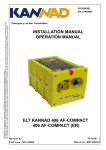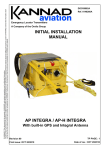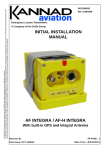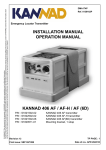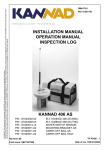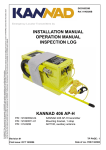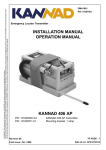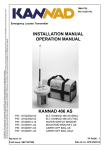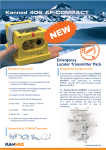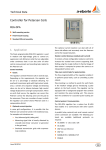Download User Manual INTEGRA AF.book
Transcript
© KANNAD: This document is the property of KANNAD and contains proprietary and confidential information. The document is loaned on the express condition that neither the document itself nor the information contained therein shall be disclosed without the express consent of KANNAD and that the information shall not be used by the recipient without prior written acceptance by KANNAD. Furthermore, the document shall be returned immediately to KANNAD upon request. DOC09078B Ref. 0146257B Emergency Locator Transmitters A Company of the Orolia Group OPERATION MANUAL AF INTEGRA / AF-H INTEGRA ELT With built-in GPS & Integral Antenna Revision 01 First issue: OCT 20/2010 TP PAGE : 1 Date of rev.: MAY 09/2011 Users are kindly requested to notify KANNAD of any discrepancy, omission or error found in this manual. Please report to our customer support: E-mail: [email protected] Tel.: +33 (0)2 97 02 49 00 OPERATION MANUAL AF INTEGRA / AF-H INTEGRA ELT RECORD OF REVISIONS REV. Nb REVISION DATE INSERTION DATE BY 00 OCT 20/2010 OCT 20/2010 J.S. 01 MAY 09/2011 MAY 09/2011 J.S. ROR PAGE: 1 MAY 09/2011 OPERATION MANUAL AF INTEGRA / AF-H INTEGRA ELT RECORD OF REVISIONS PAGE INTENTIONALLY LEFT BLANK ROR PAGE: 2 MAY 09/2011 OPERATION MANUAL AF INTEGRA / AF-H INTEGRA ELT LIST OF EFFECTIVE PAGES SUBJECT PAGE DATE Title Page TP 1 MAY09/2011 ROR 1 MAY09/2011 ROR 2 MAY09/2011 LEP 1 MAY09/2011 LEP 2 MAY09/2011 LEP 3 MAY09/2011 LEP 4 MAY09/2011 TOC 1 MAY/09/2011 TOC 2 MAY/09/2011 INTRO 1 MAY/09/2011 INTRO 2 MAY/09/2011 1 MAY/09/2011 2 MAY/09/2011 3 MAY/09/2011 4 MAY/09/2011 5 MAY/09/2011 6 MAY/09/2011 101 MAY/09/2011 102 MAY/09/2011 Record of Revisions List of Effective Pages Table of Contents Introduction System Overview System Functional Description and Operation LEP PAGE: 1 MAY 09/2011 OPERATION MANUAL AF INTEGRA / AF-H INTEGRA ELT LIST OF EFFECTIVE PAGES SUBJECT PAGE DATE 103 MAY/09/2011 104 MAY/09/2011 105 MAY/09/2011 106 MAY/09/2011 107 MAY/09/2011 108 MAY/09/2011 109 MAY/09/2011 110 MAY/09/2011 111 MAY/09/2011 112 MAY/09/2011 201 MAY/09/2011 202 MAY/09/2011 203 MAY/09/2011 204 MAY/09/2011 205 MAY/09/2011 206 MAY/09/2011 207 MAY/09/2011 208 MAY/09/2011 301 MAY/09/2011 302 MAY/09/2011 303 MAY/09/2011 304 MAY/09/2011 401 MAY/09/2011 Installation / Removal Check Troubleshooting LEP PAGE: 2 MAY 09/2011 OPERATION MANUAL AF INTEGRA / AF-H INTEGRA ELT LIST OF EFFECTIVE PAGES SUBJECT Schematics and Diagrams PAGE DATE 402 MAY/09/2011 501 MAY/09/2011 502 MAY/09/2011 503 MAY/09/2011 504 MAY/09/2011 601 MAY/09/2011 602 MAY/09/2011 Servicing LEP PAGE: 3 MAY 09/2011 OPERATION MANUAL AF INTEGRA / AF-H INTEGRA ELT LIST OF EFFECTIVE PAGES PAGE INTENTIONALLY LEFT BLANK LEP PAGE: 4 MAY 09/2011 OPERATION MANUAL AF INTEGRA / AF-H INTEGRA ELT TABLE OF CONTENTS INTRODUCTION ..................................................................................... 1 WARRANTY ........................................................................................... 2 Scope .................................................................................................... 2 Exclusion ............................................................................................... 2 SYSTEM OVERVIEW ............................................................................. 1 COSPAS-SARSAT System ................................................................... 1 Description ............................................................................................................. 1 World coverage with the COSPAS-SARSAT system ............................................ 2 Operation ............................................................................................................... 2 Environmental improvements of ELTs ................................................................... 2 KANNAD 406 ELT System Presentation .............................................. 3 LINE REPLACEABLE UNITS ............................................................... 5 Transmitter ............................................................................................................ 5 Bracket .................................................................................................................. 6 External antenna ................................................................................................... 6 SYSTEM FUNCTIONAL DESCRIPTION AND OPERATION ..... 101 Transmitter Functional Description ................................................... 101 Transmission ..................................................................................................... 101 Controls & Connectors ...................................................................................... 101 Working mode information ................................................................................. 102 Off ................................................................................................................... 102 Self-Test .......................................................................................................... 102 Armed .............................................................................................................. 103 On ................................................................................................................... 103 VSWR Switch function (External / Integral antenna) ......................................... 104 GPS Strategy ..................................................................................................... 104 Autonomy .......................................................................................................... 105 Electrical interfaces ........................................................................................... 106 Transmitter Technical Specifications ................................................................. 107 Equipment limitations ........................................................................ 108 Activation ........................................................................................... 108 Standby mode for automatic activation .............................................................. 108 Manual activation ............................................................................................... 108 Off ..................................................................................................... 109 Self-Test ............................................................................................ 109 Compatibility list ................................................................................ 110 Mounting brackets ............................................................................................. 110 Remote control panels (RCP) ............................................................................ 110 Outside buzzer .................................................................................................. 110 DIN-12 connector or programming dongles ....................................................... 110 External antennas .............................................................................................. 111 INSTALLATION / REMOVAL ............................................................. 201 TOC PAGE: 1 MAY 09/2011 OPERATION MANUAL AF INTEGRA / AF-H INTEGRA ELT TABLE OF CONTENTS Registration ....................................................................................... 201 General .............................................................................................................. 201 Registration in USA ........................................................................................... 201 Registration in Canada ...................................................................................... 202 Programming .................................................................................... 203 "Pin programming" option .................................................................................. 203 ELT transmitter installation procedure .............................................. 204 ELT transmitter Connection .............................................................. 206 First power up ................................................................................... 206 Removal ............................................................................................ 207 CHECK ............................................................................................... 301 Self-test ............................................................................................. 301 Periodicity .......................................................................................................... 301 Self-test procedure ............................................................................................ 301 Operational tests ............................................................................... 302 ELT operational tests ........................................................................................ 302 Test of transmitted signals ................................................................................ 302 406 MHz Transmission tests ........................................................................... 302 121.5 MHz Transmission tests ........................................................................ 303 TROUBLESHOOTING ........................................................................ 401 General ............................................................................................. 401 Faults on Self-test ............................................................................. 401 3+1 flashes 3+2 flashes 3+3 flashes 3+4 flashes 3+5 flashes 3+6 flashes ..................................................................................................... 401 ..................................................................................................... 401 ..................................................................................................... 401 ..................................................................................................... 401 ..................................................................................................... 401 ..................................................................................................... 401 SCHEMATICS & DIAGRAMS ............................................................ 501 Outline dimensions and weight with mounting bracket AF-COMPACT 501 Outline dimensions and weight with universal mounting bracket ...... 502 AF INTEGRA / AF INTEGRA (ER), axis of installation ..................... 503 AF-H INTEGRA / AF-H INTEGRA (ER), axis of installation ............. 504 SERVICING ........................................................................................ 601 Maintenance Schedule ..................................................................... 601 Periodic inspection ............................................................................................ 601 Battery replacement .......................................................................................... 601 Battery replacement requirements .................................................... 602 TOC PAGE: 2 MAY 09/2011 OPERATION MANUAL AF INTEGRA / AF-H INTEGRA ELT INTRODUCTION INTEGRA ELTs are an extension of the range of KANNAD ELTs. The development of this type of ELTs is based on the improvement of safety of flights either for light aircraft, business aircraft or commercial aviation. The safety of flights is strengthened thanks to a built-in GPS giving a more accurate position transmitted within minutes following the distress and an Integral Antenna which may replace the external antenna in case on unavailability of this last one. AF(1) INTEGRA is designed for fixed wing aircraft or helicopters, AF-H INTEGRA is designed for flat installation on board helicopters only. The AF INTEGRA (ER) and AF-H INTEGRA (ER) ELTs are evolutions of AF INTEGRA and AF-H INTEGRA ELTs. The main evolution consists in the extension to -40°C of temperature range. The instructions in this manual provide the information necessary for the installation and the operation of AF INTEGRA, AF-H INTEGRA, AF INTEGRA (ER) and AF-H INTEGRA (ER) ELTs. Servicing instructions of ELT are normally performed by shop personnel. For detailed instructions , refer to Service & Support section of Kannad Website. For the initial installation, please refer to Initial Installation Manual supplied with AF INTEGRA, AF-H INTEGRA, AF INTEGRA (ER) and AF-H INTEGRA (ER) ELTs. FOR REGULATORY REQUIREMENTS, PLEASE CONSULT YOUR NATIONAL AVIATION AUTHORITY. NOTE: (1) AF for Automatic Fixed PAGE INTRO 1 MAY 09/2011 OPERATION MANUAL AF INTEGRA / AF-H INTEGRA ELT WARRANTY 1. Scope The equipment is warranted against all material or manufacturing defect for a period of two years from the date of installation on the aircraft or thirty months from the date of shipment from KANNAD S.A.S. facilities whichever occur first. Work carried out under the warranty shall not have the effect of extending the warranty period. In respect of this warranty, after a defect has been noted by our services, the sole obligation incumbent upon us shall be the repair of the equipment or the element identified as being defective by our services or possibly its replacement free of charge, to the exclusion of all compensation or damages. This warranty covers the cost of parts and labour in our factories. The cost of transportation of the equipment replaced or repaired are the purchaser's exclusive responsibility. The risks shall be borne by the purchaser. 2. Exclusion Defects and deterioration caused by natural wear of the product or by external accident (poor maintenance, abnormal conditions of use, etc.) or by modification of the equipment and tools not recommended nor specified by our company, are excluded from the warranty. Also the warranty shall not cover visible defects which the purchaser wouldn't have formally notified KANNAD within 48 hours of receipt of the equipment. PAGE INTRO 2 MAY 09/2011 OPERATION MANUAL AF INTEGRA / AF-H INTEGRA ELT SYSTEM OVERVIEW 1. COSPAS-SARSAT System A. Description Launched in the early eighties by the four founder countries (Canada, France, Russia, USA), the COSPAS-SARSAT system provides satellite aid to search and rescue (SAR) operations for maritime, aeronautical and terrestrial vehicles anywhere in the world. It uses distress beacons fitted on mobiles and a constellation of LEO and GEO satellites which relay and process the 406 MHz signal to ground stations (LUT) where the beacon positions are determined with a precision of less than 2 NM with the Doppler effect. Several types of beacons are designed to match the various applications of the COSPAS-SARSAT system: • EPIRB (Emergency Position Indicating Radio Beacon) for maritime applications. • ELT (Emergency Locator Transmitter) for aeronautical applications. • PLB (Personal Locator Beacon) for land expeditions. Figure 1: COSPAS-SARSAT System PAGE: 1 MAY 09/2011 OPERATION MANUAL AF INTEGRA / AF-H INTEGRA ELT B. World coverage with the COSPAS-SARSAT system The major improvement is the use of the COSPAS-SARSAT system for processing aeronautical emergencies. The 406 MHz transmission carries digital data which enable the identification of the aircraft in distress and facilitate SAR operation (type of the aircraft, number of passengers, type of emergency). The 406 MHz message is transmitted to the COSPAS-SARSAT satellites. This message is downloaded to one of the 64 ground stations (44 LEOLUTs and 20 GEOLUTS). The aircraft is located by Doppler effect by the LEO satellites with a precision better than 2 NM (4 km) at any point of the earth. Thanks to the built-in GPS receiver, the position (accuracy typically about 60 meters) will be transmitted by the ELT within minutes following the distress. The 121.5 MHz frequency is no more processed by COSPAS-SARSAT system but is still used by SAR services for homing in the final stage of rescue operations. C. Operation In the event of a crash, the ELT activates automatically and transmits a sweep tone on 121.5 MHz and the 406 MHz signal. In a crash, a G-Switch (shock detector) turns the ELT "ON" when the ELT is subjected to an important change of velocity (or deceleration). Activation may also be accomplished by means of a Remote Control Panel (RCP) from the cockpit or directly from a switch of the ELT’s front panel. In the event the external antenna is unavailable due to the crash, the integral antenna will replace it to transmit the 406 MHz signal to the Cospas-Sarsat satellites. Note: The integral antenna has not been tested and approved by CospasSarsat. D. Environmental improvements of ELTs The certification of an ELT includes a range of severe mechanical tests: • resistance to flame; • impact and crush tests; • resistance up to 500 G shocks; • watertightness; • anti-deflagration; • extreme temperatures . PAGE: 2 MAY 09/2011 OPERATION MANUAL AF INTEGRA / AF-H INTEGRA ELT 2. KANNAD 406 ELT System Presentation AF INTEGRA and AF-H INTEGRA belong to the AF type of ELTs which are permanently attached to an aircraft. AF INTEGRA and AF-INTEGRA (ER) are designed to be installed on fixed wing aircraft or helicopters. AF-H INTEGRA and AF-H INTEGRA (ER) are designed for flat installation on board helicopters only. The INTEGRA ELT system (Refer to Section Figure 2: ELT system description page 4) is composed of: 1. the ELT transmitter: • P/N S1851501-01 for AF INTEGRA (ER) or, • P/N S1851501-02 for AF INTEGRA or, • P/N S1852501-01 for AF-H INTEGRA (ER) or, • P/N S1852501-02 for AF-H INTEGRA 2. a mounting bracket (P/N S1840502-01 or S1840502-02); 3. an external whip, rod or blade antenna; 4. A remote control panel(1); 5. a DIN-12 connector or programming dongle when the optional RCP is connected. Note: (1) The RCP is optional only if the commands and controls of the ELT are reachable and visible from the pilot seated position. (RTCA DO-204A): "Equipment control and indicator installed for in-flight use shall be readily accessible from the cockpit crew position. The cockpit crew shall have an unobstructed view of visual indicator when in the normal seated position." For details of approved part number of INTEGRA ELT system, Refer to Section 6. Compatibility list page 110. The transmitter and bracket are installed in the aircraft near the tail. The external antenna is mounted on the fuselage near the tail. The remote control panel is installed in the cockpit and connected to the ELT with a DIN-12 connector or a programming dongle and a 2, 3, or 4-wire bundle (not supplied) PAGE: 3 MAY 09/2011 OPERATION MANUAL AF INTEGRA / AF-H INTEGRA ELT Figure 2: ELT system description PAGE: 4 MAY 09/2011 OPERATION MANUAL AF INTEGRA / AF-H INTEGRA ELT 3. LINE REPLACEABLE UNITS A. Transmitter The AF INTEGRA and AF-H INTEGRA are ELTs designed to be installed onboard aircraft to transmit a distress signal on frequencies: • 406 MHz (COSPAS-SARSAT frequency) for precise pinpointing and identification of the aircraft in distress. • 121.5 MHz used for homing in the final stages of the rescue operations. The AF INTEGRA and AF-H INTEGRA are certified as Automatic Fixed (AF) ELTs with the approved external antennas. The housing of AF INTEGRA and AF-H INTEGRA transmitters are made of molded plastic with excellent mechanical resistance. The ELT housing is designed with no sharp edges. Figure 3: ELT Transmitter PAGE: 5 MAY 09/2011 OPERATION MANUAL AF INTEGRA / AF-H INTEGRA ELT B. Bracket The bracket installed near the tail is designed to fix the ELT with a Velcro® strap. This enables quick removal of the ELT for maintenance or exchange. Figure 4: ELT Transmitter with Mounting Bracket The transmitter may be installed on its standard mounting bracket (P/N S1840502-01) or on an Universal Mounting Bracket (P/N S1840502-02) to re-use existing drilling for retrofit (Refer to DOC09081, Initial Installation Manual for drilling masks and outline dimensions of these brackets). C. External antenna Only approved antennas may be installed (Refer to Section 6. Compatibility list page 110). Connection to the ELT will be carried out with a 50 Ohm coaxial cable (RG58 for example) ended with a male BNC connector. IMPORTANT NOTICE: KANNAD recommends a cable with radio electric properties similar or better to those of a RG58 cable. Note: the 50 Ohm coaxial and the male BNC connector are not supplied PAGE: 6 MAY 09/2011 OPERATION MANUAL AF INTEGRA / AF-H INTEGRA ELT SYSTEM FUNCTIONAL DESCRIPTION AND OPERATION 1. Transmitter Functional Description A. Transmission The transmitter can be activated either automatically when the crash occurs (thanks to a shock sensor) or manually (thanks to a switch on the transmitter itself or on a RCP). The transmitter is designed to transmit on two frequencies (121.5 and 406 MHz). The 121.5 Mhz is mainly used for homing in the final stages of the rescue operations. The 406 MHz frequency is used by the COSPAS-SARSAT satellites for precise pinpointing and identification of the aircraft in distress. Once activated, the transmitter operates continuously on 121.5 MHz. During operations, a digital message is transmitted on 406.037 MHz every 50 seconds. B. Controls & Connectors The following controls are to be found on the ELT front panel (from left to right): 1. 3-position switch ARM/OFF/ON; 2. Visual indicator (red); 3. DIN 12 socket for connection to an optional Remote Control Panel, a programming dongle or a programming equipment; 4. BNC connector for the external antenna. Figure 101: Front Panel PAGE: 101 MAY 09/2011 OPERATION MANUAL AF INTEGRA / AF-H INTEGRA ELT The red light gives an indication on the working mode of the beacon: • after the self test: - a series of short flashes indicates the self test failed; - one long flash indicates a correct self test; • in operating mode: - periodic flashes during 121.5 transmission; - long flash during 406 transmission. A buzzer gives audio information on the beacon working: • continuous tone during self test; • 1 beep every 0.7 second during 121.5 transmission; • silence during 406 transmission. C. Working mode information The ELT has 4 different modes: • Off. • Self-test (temporary mode). • Armed (standby mode to enable automatic activation by the shock sensor or by an optional remote control panel). • On (transmission). Transmission is effective if the beacon is activated (either manually on the ELT control panel, automatically by the shock sensor, or remotely by the "ON" switch of an optional remote control panel when connected). (1) Off The ELT is off when the switch is in position "OFF", no part of the ELT is energized. This mode must only be selected when the ELT is removed from the aircraft or when the aircraft is parked for a long period or for maintenance. (2) Self-Test The self-test mode is a temporary mode (max duration 15 sec) in which the ELT checks the main characteristics of the transmitter (Battery voltage, Programming...) and enables digital communication with programming and test equipment. This mode is selected: • when switching from "OFF" to "ARM"; • when switching to "RESET / TEST" on an optional Remote Control Panel (provided that the switch of the ELT is in position "ARM"); • when switching to "ON" prior to transmission. The buzzer operates during the self-test procedure. PAGE: 102 MAY 09/2011 OPERATION MANUAL AF INTEGRA / AF-H INTEGRA ELT After about 10 seconds, the test result is displayed on the visual indicator as follows: • One long flash indicates valid test. • A series of short flashes indicates false test result. The number of flashes indicates the type of failure: • 3 + 1 = LOW BATTERY VOLTAGE. • 3 + 2 = LOW TRANSMISSION POWER. • 3 + 3 = FAULTY VCO LOCKING (FAULTY FREQUENCY). • 3 + 4 = NO IDENTIFICATION PROGRAMMED. • 3 + 5 = FAULTY VSWR (LINK TO EXTERNAL ANTENNA). • 3 + 6 = GPS SERIAL LINK. It is recommended to test the ELT regularly in order to detect any possible failure (Refer to Section A. Periodicity page 301). The number of self-tests carried out is recorded. This information is available when the ELT is connected to a programming and test equipment (PR600). (3) Armed In order to enable activation by the G-Switch or with an optional Remote Control Panel, the ELT must be in standby mode with the switch in the "ARM" position. This mode is mandatory during flight. The ELT should remain in the "ARM" position except when the aircraft is parked for a long period or for maintenance. (4) On This mode is selected: • manually by switching the ELT to "ON"; • by switching an optional Remote Control Panel switch to "ON" (provided that the ELT switch is in the "ARM" position); • automatically when a crash occurs (provided that the ELT switch is in the "ARM" position). When this mode is selected, the ELT starts transmitting: • after 50 seconds on 406 MHz (one 406 MHz burst every 50 seconds) to the external antenna; • after the GPS lock on 121.5 MHz (continous transmission between each 406 MHz burst). If GPS lock does not occur within 5 minutes, the 121.5 MHz will be activated. PAGE: 103 MAY 09/2011 OPERATION MANUAL AF INTEGRA / AF-H INTEGRA ELT The red visual indicator on the ELT (and on an optional remote control panel when connected) flashes and the buzzer operates. • Red visual indicator: - 1 short flash during ELT transmission on 121.5 MHz (every 0.7 seconds); - 1 long flash during ELT transmission on 406 MHz (every 50 seconds). • Buzzer: - 1.5 Hz pulse signal (recurrence 0.7 s) during ELT transmission on 121.5 MHz [except if the ELT has switched to internal antenna: Refer to D. VSWR Switch function (External / Integral antenna)]. In case of accidental activation, the ELT can be reset either by switching it to "OFF" or by switching to "RESET" on an optional Remote Control Panel when connected. The number of 406 MHz bursts transmitted is recorded. This information is available when the ELT is connected to a programming and test equipment (PR600). D. VSWR Switch function (External / Integral antenna) During the 406 MHz burst, the Voltage Standing Wave Ratio (VSWR) is measured. After 5 bursts with wrong VSWR measurements, the ELT switches from the external to the internal antenna in order to optimize transmitted signal. In ON mode, after 36 bursts, the ELT decides to re-switch or not according to the result of 2 new VSWR measurements. NOTE: when shifting from the external to the integral antenna the pulse signal of the buzzer shifts from one beep every 0.7 second to 2 beeps every 0.7 second. Note: The integral antenna has not been tested and approved by CospasSarsat. E. GPS Strategy To avoid consumption, the GPS receiver is not power supplied in ARM mode. After a crash (automatic activation) or manual activation, the GPS will try to acquire a position in continuous mode during one hour and by different sequences up to 24 hours of 406 MHz transmission. If the GPS receiver acquires a valid position, then the message will contain the true position in the next 406 MHz burst. If the GPS receiver does not acquire a valid position, then the message will contain the default value (GPS position not valid). According to § 4.5.5.2 of Cospas Sarsat C/S T001, if, after providing valid data, PAGE: 104 MAY 09/2011 OPERATION MANUAL AF INTEGRA / AF-H INTEGRA ELT the navigation input fails or is not available, the beacon message retains the last valid position for 4 hours (± 5 min) after the last valid position data input. After 4 hours the encoded position is set to the default values. F. Autonomy The energy is provided by a battery pack composed of a LiMnO2 two-element battery (See pages page 107 & page 602 for Kit battery reference). Lithium cells, lithium batteries and equipment containing such batteries are subjected to regulations and classified under class 9 as from 1st of January 2003. Battery shall be replaced according to the expiriy date indicated on the ELT. NOTE: ELT Battery useful life: 6 years in service life (ETSO/TSO/COSPASSARSAT margins included). IMPORTANT: If the ELT has been activated for more than 1 hour, the battery shall be replaced (See page 602 section 2, Battery replacement requirements) With new batteries, the duration of the 121.5 transmission is over 48 hours at -20°C for INTEGRA ELTs and over 48 hours at -40°C for INTEGRA (ER) ELTs. As it is therefore preferable to keep the battery power for 121.5 MHz homing frequency transmission for the rescue operations, in compliance with COSPAS-SARSAT specifications, the 406 MHz transmission is deliberately stopped after 24 hours to extend the 121.5 MHz transmission for as long as possible. PAGE: 105 MAY 09/2011 OPERATION MANUAL AF INTEGRA / AF-H INTEGRA ELT G. Electrical interfaces J1 DIN 12 socket J1 is dedicated for connection to an optional Remote Control Panel, to a Programming or Maintenance Dongles or to a programming equipment (PR600). IMPORTANT: Shielded cables are recommended. The required wires are AWG24. J1 Viewed from Front Face PIN Signal Name Destination Direction J1-A RCP RESET RCP J1-B DONGLE RX SMM / PGM IN J1-C DONGLE CS SMM OUT J1-D DONGLE SK SMM OUT J1-E DONGLE TX SMM / PGM OUT J1-F DONGLE ALE2P SMM OUT J1-G RCP COMMON RCP OUT J1-H RCP BUZZER RCP OUT J1-J RCP LED RCP OUT J1-K RCP ON RCP OUT J1-L DONGLE GND SMM / PGM OUT J1-M RCP 2W COMMON RCP IN OUT Table 1: J1 connector pin-out J2 BNC female connector J2 is used to connect the external antenna through a 50 Ω coaxial cable. IMPORTANT NOTICE: The use of a low attenuation coaxial cable is recommended. The maximum permitted attenuation in the coaxial is 2db@400 MHz. PAGE: 106 MAY 09/2011 OPERATION MANUAL AF INTEGRA / AF-H INTEGRA ELT H. Transmitter Technical Specifications TYPE • Two-frequency ELT (121.5 / 406.037 MHz) • Automatic Fixed • COSPAS-SARSAT Class INTEGRA AF (ER)/AF-H (ER): Class I, -40°C to +55°C. INTEGRA AF/AF-H: Class II, -20°C to +55°C. 406 MHz TRANSMISSION • Frequency: 406.037 MHz+/-1 kHz • Output power: 5W (37 dBm +/- 2 dB) • Modulation type: 16K0G1D (Biphase L encoding) • Transmission duration: 520ms (long message) every 50 s. • Autonomy INTEGRA (ER): 24 Hours @-40°C INTEGRA: 24 Hours @-20°C 121.5 MHz TRANSMISSION • Frequency: 121.5 MHz +/- 6 kHz • Output power: 50 to 400 mW (17dBm to 26 dBm), typical 100 mW • Modulation type: 3K20A3X • Modulation rate: > 85 % • Frequency of modulation signal: 1600 Hz to 300 Hz with decreasing sweep • Autonomy INTEGRA (ER): over 48 hours@-40°C INTEGRA: over 48 hours@-20°C. G-SWITCH SENSOR Mechanical G-switch sensor compliant with EUROCAE ED62 specifications. RF Fied strenght limits INTEGRA (ER): 0.471 V/m INTEGRA: 0.474 V/m CONTROLS • ARM / OFF / ON switch • DIN12 socket for RCP and pin programming option. • Bright red visual indicator • Buzzer • BNC antenna connector BATTERY KIT BAT200, P/N: S1840510-01 LiMnO2 two-element battery for transmitter power supply Battery expiry date: 7 years from date of cell manufacturing HOUSING Material: Polycarbonate Color: Yellow (color compounded) Transmitter dimensions: 131 x 86 x 75.4 mm ( 5.157 x 3.385 x 2.968 inches) Weight: • AF: typical 755 g. (1.66 lb). • AF-H: typical 760 g. (1.67 lb). Tightness: O-ring ENVIRONMENTAL CONDITIONS RTCA DO-160F / EUROCAE ED14F Section 4 to 26: INTEGRA AF / AF (ER) [ED62A]X[ED62A]A[ED62A][R(C&C1)]X WXXXSZXXXZ[ED62A]B[XXG33]XXA [ED62A] INTEGRA AF-H / AF-H (ER) [ED62A]X[ED62A]A[ED62A][U(G)]XWXX XSZXXXZ[ED62A]B[XXG33]XXA [ED62A] QUALIFICATIONS ETSO-2C91a & ETSO-2C126 / TSOC126a FOR USE OUTSIDE OF THE USA OR EASA RULES, CONTACT YOUR LOCAL CIVIL AVIATION AUTHORITY. PAGE: 107 MAY09/2011 092011 MAY OPERATION MANUAL AF INTEGRA / AF-H INTEGRA ELT 2. Equipment limitations Antenna - ELT cable with maximum permitted attenuation: 2db@400 MHz. WARNING: ELTs are radio transmitters which emit radio frequency radiation when activated. When transmitting, the user's minimum distance of exposure is 0.20 meter. For RF Fied strenght limits, please Refer to Section H. Transmitter Technical Specifications page 107. RF Fied strenght limits have been calculated according to Canadian RSS-102 Standard "Radio Frequency (RF) Exposure Compliance of Radiocommunication Apparatus (All Frequency Bands)". For Canadian user, any information and/or contact on Radiofrequency (RF) Energy and Health may be found on: http://www.ic.gc.ca/eic/site/smt-gst.nsf/eng/sf08792.html. 3. Activation A. Standby mode for automatic activation In order to be automatically activated by the crash sensor, the ELT must be in standby mode. This mode is mandatory during the flight. We recommend to switch off the ELT only when removed from the aircraft or when the aircraft is parked for a long period or for a maintenance operation. • Check that the antenna is correctly connected. • Switch to " ARM". To operate the ELT with an optional Remote Control Panel, ensure that: • The ELT switch is the "ARM" position . B. Manual activation • Check that the antenna is correctly connected. • Switch to " ON " (either on the ELT or on an optional Remote Control Panel when connected): - The ELT starts with the self-test sequence then, after 50 sec., transmits on: • 406 MHz (one 406 MHz burst every 50 seconds); • 121.5 MHz (continous transmission between each 406 MHz burst after the GPS lock) . - During transmission, the buzzer operates and the red visual indicator flashes. PAGE: 108 MAY09/2011 092011 MAY OPERATION MANUAL AF INTEGRA / AF-H INTEGRA ELT 4. Off It is possible to stop the ELT in case of unintentional activation: • Switch to " OFF ". Regulations state that no transmission must be interrupted unless every means are used to contact and inform the Air Traffic Controller of this action. Important notice: As 406 MHz transmission is effective 50 seconds after the ELT activation, if it is switched off within this delay, no further radio contact will be necessary. 5. Self-Test Refer to Section 1. Self-test page 301 PAGE: 109 MAY 09/2011 OPERATION MANUAL AF INTEGRA / AF-H INTEGRA ELT 6. Compatibility list A. Mounting brackets Designation Part Number COMPACT MOUNTING BRACKET KIT S1840502-01 COMPACT UNIVERSAL MOUNTING BRACKET KIT S1840502-02 B. Remote control panels (RCP) KANNAD Designation Part Number RC100 KIT S1820513-03 RC102 KIT S1820513-21 RC200 S1820513-11 RC300 S1820513-09 RC300-NVG S1820513-10 RC600 NVG (Y) S1820513-12 RC600-NVG (W) S1820513-13 C. Outside buzzer KANNAD Designation Part Number OUTSIDE BUZZER KIT S1820515-06 D. DIN-12 connector or programming dongles Designation Part Number DIN-12 connector S1820514-03 Programming dongle S1820514-01 Programming A320 S1820514-04 Programming dongle A330-A340 S1820514-05 Programming dongle Assy S1820514-06 PAGE: 110 MAY 09/2011 OPERATION MANUAL AF INTEGRA / AF-H INTEGRA ELT E. External antennas KANNAD Designation Manufacturer KANNAD Part Number ANT300 CHELTON 1327-82 0124220 WHIP ANT AV200 RAMI AV-200 0146150 ROD ANT AV300 RAMI AV-300 0146151 BLADE ANT500 SENSOR SYSTEMS S65-8282-406 0124222 BLADE ANT560 DAYTON GRANGER ELT10-696-1 0145787 BLADE ANT650 CHELTON 2624-82 0124251 N/A CHELTON 21-41 N/A PAGE: 111 MAY 09/2011 OPERATION MANUAL AF INTEGRA / AF-H INTEGRA ELT PAGE INTENTIONALLY LEFT BLANK PAGE: 112 MAY 09/2011 OPERATION MANUAL AF INTEGRA / AF-H INTEGRA ELT INSTALLATION / REMOVAL 1. Registration A. General The ELT must be registered prior to installation onboard. When a 406 MHz ELT is installed in an aircraft, it is imperative that the aircraft owner register the ELT. Each 406 MHz ELT contains a unique identification code that is transmitted to the satellite. This helps the “Rescue Coordination Center” (RCC) to determine whether an emergency has actually occurred. The unique identification permits accessing a data base. The registration card available from the local registration authority must be completed and returned to this authority. Any change of ownership shall also be declared and registered with the local registration authority. B. Registration in USA Mail or Fax your registration form to: NOAA/SARSAT NSOF, E/SP3 4231 Suitland Road Suitland, MD 20746 or Save Time! Register your beacon online at: www.beaconregistration.noaa.gov All online registrations will be entered into the National 406 MHz Beacon Registration Database on the same day of entry. Registration forms received via postal mail will be entered within 2 business days of receipt. For online registrations, a confirmation letter with your completed registration information form will be sent immediately via e-mail or fax (if provided). Confirmation letters sent via postal mail should arrive within two weeks. Once your registration confirmation is received, please review all information. Any changes or updates to your registration information can be done via the internet, fax, e-mail or postal mail. If you do not receive your registration confirmation from NOAA on the same day you submit it over the internet or within two weeks if you submit it by postal mail, please call NOAA toll-free at: 1-888-212-SAVE (7283) or 301-817-4515 for assistance. After initial registration (or re-registration) you will receive a NOAA Proof of Registration Decal by postal mail. This decal is to be affixed to the beacon and should be placed in such a way that it is clearly visible. If for some reason you PAGE: 201 MAY 09/2011 OPERATION MANUAL AF INTEGRA / AF-H INTEGRA ELT do not receive the registration decal within two weeks, please call NOAA tollfree at: 1-888-212-SAVE (7283) or 301-817-4515. Failure to register, re-register (as required every two years), or to notify NOAA of any changes to the status of your 406 MHz beacon could result in penalties and/or fines being issued under Federal Law. The owner or user of the beacon is required to notify NOAA of any changes to the registration information at any time. By submitting this registration the owner, operator, or legally authorized agent declares under penalty of law that all information in the registration information is true, accurate, and complete. Providing information that is knowingly false or inaccurate may be punishable under Federal Statutes. Solicitation of this information is authorized by Title 47 - Parts 80, 87, and 95 of the U.S. Code of Federal Regulations (CFR). Additional registration forms can be found on the NOAA-SARSAT website at: www.sarsat.noaa.gov or at: www.beaconregistration.noaa.gov C. Registration in Canada Beacon information is held in the Canadian Beacon Registry maintained by the National Search and Rescue Secretariat for use in search and rescue operations. Online access to the Registry is available for all beacon owners to register new beacons or to update their beacon information. You can add or update your beacon information by accessing the registry directly, sending in a completed registration form or by talking to one of our beacon registry representatives. You can access the registry: • online: www.canadianbeaconregistry.com • by email: [email protected] • by fax: 1-613-996-3746 • by telephone: 1-800-727-9414 or 1-613-996-1616 The registration information must be updated when the aircraft ownership changes as per the Canadian Airworthiness Notice AN B029 (refer to following link): http://www.nss.gc.ca/site/Emergency_Beacons/canadian_beacon_registry_e.asp Additional information and registration forms can be found on the Canadian NSS website at: http://www.nss.gc.ca/site/cospas-sarsat/INTRO_e.asp PAGE: 202 MAY 09/2011 OPERATION MANUAL AF INTEGRA / AF-H INTEGRA ELT 2. Programming A. "Pin programming" option The INTEGRA family offers pin-programming capabilities to facilitate maintenance operations especially in the case of removals and/or replacement. A special DIN 12 connector with a Serial Memory Module (called "Programming Dongle") is connected to the ELT when installed onboard. This Programming Dongle contains the identification information of the aircraft and remains onboard the aircraft. When an unprogrammed ELT is installed and connected to this Programming Dongle and the "ELT" is switched to "ARM", it automatically updates its own memory with the identification data contained in the Programming Dongle memory. When the ELT is removed from the aircraft, it keeps its identification data. For maintenance purposes, it is possible to delete the identification information of the ELT by connecting a "Maintenance Dongle" to the ELT. Any accidental transmission with this "maintenance dongle" will not involve SAR operation as the identification code transmitted is recognised by COSPAS-SARSAT as "not onboard". When a maintenance dongle is connected: • Country code is 227 (France). • Protocol is Test. • Identification number is K + 6 digits (the 6 digits of the CSN number). If the pin programming option is selected by the owner, the following equipment are required: • a "Programming Dongle" on each aircraft; • a "Maintenance Dongle" on each ELT spare. Figure 201: Maintenance Dongle PAGE: 203 MAY 09/2011 OPERATION MANUAL AF INTEGRA / AF-H INTEGRA ELT 3. ELT transmitter installation procedure Refer to Figure 202: Installing the transmitter on the bracket page 205 NOTE: Intial installation (bracket installation and first wiring) is described in Initial installation manual, DOC09081 also supplied with the transmitter. 1. Mount the transmitter on the bracket • For AF INTEGRA or AF INTEGRA (ER), with "Flight direction" arrow of the ELT pointed towards the front of the aircraft according to Section 3. AF INTEGRA / AF INTEGRA (ER), axis of installation page 503. For AF-H INTEGRA or AF-H INTEGRA (ER), with "Flight direction" arrow of the ELT pointed towards the front or downwards the helicopter according to Section 4. AF-H INTEGRA / AF-H INTEGRA (ER), axis of installation page 504. 2. Slide the self-stripping strap through the buckle. Ensure the buckle is correctly positioned (indifferently on right or left side of ELT) regarding the horizontal center line of ELT as shown Detail A. 3. Fasten the self-stripping strap tightly. PAGE: 204 MAY 09/2011 OPERATION MANUAL AF INTEGRA / AF-H INTEGRA ELT Figure 202: Installing the transmitter on the bracket PAGE: 205 MAY 09/2011 OPERATION MANUAL AF INTEGRA / AF-H INTEGRA ELT 4. ELT transmitter Connection 1. Connect the cable of the outside antenna to the BNC connector of the front panel. 2. Set the 3-position switch of the front panel to ARM. Figure 203: Installation, controls and connectors • Perform the first power up procedure (see below). 5. First power up Perform the following tests: 1. ELT operational tests: • connect the external antenna to J2; • switch the ELT from OFF to ARM; • check that the Self-Test result is OK (one long flash). 2. 406 & 121.5 MHz transmission tests (optional): Refer to Section B. Test of transmitted signals page 302. At the end of the first power up procedure, switch the ELT to ARM. The ELT is now in stand by mode and ready to be activated: • either automatically by G-Switch sensor if a crash occurs; • or manually by an optional Remote Control Panel (when connected). Note : switching to ON directly on the ELT front panel will also activate the ELT. PAGE: 206 MAY 09/2011 OPERATION MANUAL AF INTEGRA / AF-H INTEGRA ELT 6. Removal 1. Switch the ELT to OFF. 2. Disconnect the external antenna from the BNC connector of the ELT. 3. If connected, disconnect the DIN 12 Connector of Remote Control Panel bundle from the DIN12 socket of the ELT. 4. Unfasten the self-stripping strap. 5. Remove the transmitter from the bracket. Figure 204: Removing the transmitter PAGE: 207 MAY 09/2011 OPERATION MANUAL AF INTEGRA / AF-H INTEGRA ELT PAGE INTENTIONALLY LEFT BLANK PAGE: 208 MAY 09/2011 OPERATION MANUAL AF INTEGRA / AF-H INTEGRA ELT CHECK 1. Self-test A. Periodicity EUROCAE ED-62A Recommendations § 2.8.9 : "The battery source shall provide sufficient capacity for a self-test to be conducted according to the period specified by the manufacturer or at least once a month according to Cospas-Sarsat requirement." § 7.5 : "Check the self-test function according to manufacturer’s recommendation and that such a test shall occur at least once every six months." Manufacturer Recommendations It is recommended by the manufacturer to test the ELT to detect any possible failure. Operational check must be performed regularly by a pilot or maintenance personnel from the cockpit (Remote Control Panel). It is recommended to perform a self-test at least once every six months but it should not be done more than once a month. Each self-test consumes energy from the battery. Should self-tests be carried out more often than the maximum allowed, the battery life-time might be shorter than specified. B. Self-test procedure • Check that the antenna is correctly connected Do not perform self-test without antenna connected. • Tune aircraft radio to 121.5 MHz and ensure you can hear it. • Switch from position "OFF" to position "ARM" or press RESET & TEST on the Remote Control Panel (ensure that the ELT switch is in position "ARM"). • Listen for the buzzer - it operates during the whole Self-test procedure. Close to the end of self-test a short (3 sweeps) 121.5 transmission is made - confirm this on the aircraft radio. • After a few seconds, the test result is displayed with the red visual indicator and the buzzer will sound: • One long flash indicates that the system is operational and that no error conditions were found. • A series of short flashes indicates the test has failed. Remark: The number of flashes gives an indication of the faulty parameter detected during the self-test. PAGE: 301 MAY 09/2011 OPERATION MANUAL AF INTEGRA / AF-H INTEGRA ELT 3+1 LOW BATTERY VOLTAGE 3+2 LOW RF POWER 3+3 FAULTY VCO LOCKING (FAULTY FREQUENCY) 3+4 NO IDENTIFICATION PROGRAMMED 3+5 FAULTY VSWR (EXT. ANTENNA) 3+6 GPS SERIAL LINK If self-test fails, contact the distributor as soon as possible. Unless a waver is granted, flight should be cancelled (refer to National Aviation Authorities). 2. Operational tests These tests must be performed by maintenance personnel when performing the first power up procedure or to check the transmitter (Refer to B. Test of transmitted signals). A. ELT operational tests NOTE: ELT operational tests only provide the aircraft operator with an indication that the ELT is transmitting; however, a positive result cannot be interpreted as meaning that the ELT meets all operational parameters. • connect the outside antenna to J2; • switch the ELT from OFF to ARM; • check that the Self-Test result is OK (one long flash). B. Test of transmitted signals (1) 406 MHz Transmission tests This test should be carried out with a COSPAS-SARSAT decoder. Note: If a COSPAS-SARSAT decoder is not available, the coding sheet supplied by the programmer for the beacon (or dongle) with the corresponding CSN proves that the beacon (or dongle) is correctly programmed. Skip to § (2) 121.5 MHz • Perform self-test (switch ELT from OFF to ARM). • Check with the COSPAS-SARSAT decoder that, except for the 5th and the 6th digits, the decoded message is identical to the programmed message. NOTE:The message transmitted during self-test sequence always begins with FF FE D0 whereas a programmed message begins with FF FE 2F. Example of message programmed in ELT: PAGE: 302 MAY 09/2011 OPERATION MANUAL AF INTEGRA / AF-H INTEGRA ELT FF FE 2F 96 E3 AF 0F 0F 7F DF FF 62 60 B7 83 E0 F6 6C Example of same message decoded by Cospas-Sarsat Decoder: FF FE D0 96 E3 AF 0F 0F 7F DF FF 62 60 B7 83 E0 F6 6C NOTE: for location protocol beacons, the content of the encoded position data field of the self-test message shall be the default values (extract from C/S T001 Cospas Sarsat. (2) 121.5 MHz Transmission tests This check shall only be conducted during the first five minutes of any UTC, (co-ordinated universal time) hour, and restricted in duration to not more than five seconds. Be sure to notify any nearby control tower of your intentions. This test must be carried out with a VHF receiver either with the aircraft VHF receiver or with a not on-board VHF receiver. IMPORTANT: Aircraft VHF receiver may be used only if 406 MHz test was carried out with a Cospas-Sarsat decoder, otherwise check 121.5 MHz using a VHF receiver (not the on-board VHF receiver) several dozens meters away from the antenna. This ensures to validate the antenna. • Tune VHF receiver to 121.5 MHz; • Start transmission: - Switch ELT to ON. • Only 2 "sweep tones" are heard after 5 seconds, then the 121.5 MHz stops. • Stop transmission: - Switch to OFF; - continue to listen to 121.5 MHz for a few seconds to ensure that the ELT does not continue to transmit after the test is terminated. IMPORTANT: If the ELT operates for approximately 50 seconds, a 406 MHz signal is transmitted and is considered valid by the satellite system. Switch ELT to ARM. PAGE: 303 MAY 09/2011 OPERATION MANUAL AF INTEGRA / AF-H INTEGRA ELT PAGE INTENTIONALLY LEFT BLANK PAGE: 304 MAY 09/2011 OPERATION MANUAL AF INTEGRA / AF-H INTEGRA ELT TROUBLESHOOTING 1. General Procedure for fault isolation onboard uses the indicator light (red visual indicator) of the ELT’s front panel. This indicator light is activated by a self-test capability within the ELT. 2. Faults on Self-test When the self-test is carried out, the number of flashes on ELT or RCP’s visual indicator gives an indication of the faulty parameter detected during the selftest. (1) 3+1 flashes - Low battery voltage: Replace battery: refer to relevant CMM for tests and repair. (2) 3+2 flashes - Low RF power: Check 406 MHz power: refer to relevant CMM for tests and repair. (3) 3+3 flashes - Faulty VCO locking (faulty frequency): Check frequencies: refer to relevant CMM for tests and repair. (4) 3+4 flashes - No identification programmed Check programming:refer to relevant CMM for tests and repair. (5) 3+5 flashes - VSWR Fault Check correct connection of antenna Perform a VSWR measurement (6) 3+6 flashes - GPS serial link fault Check GPS receiver: refer torefer to relevant CMM for tests and repair. Note: for CMM download and other servicing instructions, refer to Service & Support section of Kannad website. PAGE: 401 MAY 09/2011 OPERATION MANUAL AF INTEGRA / AF-H INTEGRA ELT PAGE INTENTIONALLY LEFT BLANK PAGE: 402 MAY 09/2011 OPERATION MANUAL AF INTEGRA / AF-H INTEGRA ELT SCHEMATICS & DIAGRAMS 1. Outline dimensions and weight with mounting bracket AF-COMPACT PAGE: 501 MAY 09/2011 OPERATION MANUAL AF INTEGRA / AF-H INTEGRA ELT 2. Outline dimensions and weight with universal mounting bracket PAGE: 502 MAY 09/2011 OPERATION MANUAL AF INTEGRA / AF-H INTEGRA ELT 3. AF INTEGRA / AF INTEGRA (ER), axis of installation PAGE: 503 MAY 09/2011 OPERATION MANUAL AF INTEGRA / AF-H INTEGRA ELT 4. AF-H INTEGRA / AF-H INTEGRA (ER), axis of installation PAGE: 504 MAY 09/2011 OPERATION MANUAL AF INTEGRA / AF-H INTEGRA ELT SERVICING 1. Maintenance Schedule Battery replacement: carried out by an accredited PART 145 or FAR 145 (or equivalent) maintenance station. Periodic inspection: depending if the ELT is opened or not, PART 145 or FAR 145 (or equivalent) may be required. Refer to local regulations A. Periodic inspection Note: (if required by the relevant Civil Aviation Authority). Some Civil Aviation Authorities may require the ELT be tested periodically. In this case, refer to Service Letter SL S1840501-25-05 "Guidelines for periodic inspection" available on the Service & Support section of Kannad Website. B. Battery replacement Testing of various elements and parameters of the ELT is mandatory when the battery is replaced. • For battery replacement interval, Refer to § 2. Battery replacement requirements, page 602. • The testing procedure associated with the battery replacement is described in the relevant CMM For CMM download and other servicing instructions, refer to Servcie & Support section of Kannad Website. PAGE: 601 MAY 09/2011 OPERATION MANUAL AF INTEGRA / AF-H INTEGRA ELT 2. Battery replacement requirements Battery replacement is mandatory: • after more than 1 hour of real transmission (cumulated duration); • before or on the battery expiration date; • after use in an emergency; • after an inadvertant activation of unknown duration. Only original and approved battery pack included in battery KIT BAT200 (P/N S1840510-01) supplied by KANNAD can be installed. [SAFT-FRIWO , Lithium Manganese Dioxide, 2 x M20 (D-type) cells] PLEASE CONTACT YOUR LOCAL DISTRIBUTOR KANNAD refuse all responsibility and invalidate all warranty should other packs be installed. Battery available from any KANNAD distributor or dealer. List of distributor available on our Web site: http://www.kannad.com KANNAD Z.I. des Cinq Chemins BP23 56520 GUIDEL - FRANCE Telephone: +33 (0)2 97 02 49 49 Fax: +33 (0)2 97 65 00 20 Web: http://www.kannad.com - E-mail: [email protected] Support: [email protected] Tel.: +33 (0)2 97 02 49 00 PAGE: 602 MAY 09/2011 Distributed by Manufactured by KANNAD Z.I. des Cinq Chemins BP23 56520 GUIDEL - FRANCE Tél. / Phone : +33 (0) 2 97 02 49 49 Fax : +33 (0) 2 97 65 00 20 A Company of the Orolia Group DOC09078B Ref:0146257B





















































